- Table of Content
- 1.Geomagnetic st...
- 2.STCE on demand...
- 3.Job Opportunit...
- 4.Open Doors at ...
- 5.Review of Spac...
- 6.International ...
- 7.Noticeable Sol...
- 8.PROBA2 Observa...
- 9.Geomagnetic Ob...
- 10.Review of Iono...
- 11.The SIDC Space...
- 12.Upcoming activ...
2. STCE on demand: Ionospheric SWIC Course
3. Job Opportunity in Bavaria
4. Open Doors at the Humain Radioastronomy Station
5. Review of Space Weather
6. International Sunspot Number by SILSO
7. Noticeable Solar Events
8. PROBA2 Observations
9. Geomagnetic Observations in Belgium
10. Review of Ionospheric Activity
11. The SIDC Space Weather Briefing
12. Upcoming activities
Geomagnetic storms explained
A few weeks ago, Quest Magazine contacted Petra-from-the-STCE and asked her to explain what geomagnetic storms are and why we should care about them.
A very entertaining interview led to an article in this popular science magazine from the Netherlands and it discusses these storms and their possible effects.
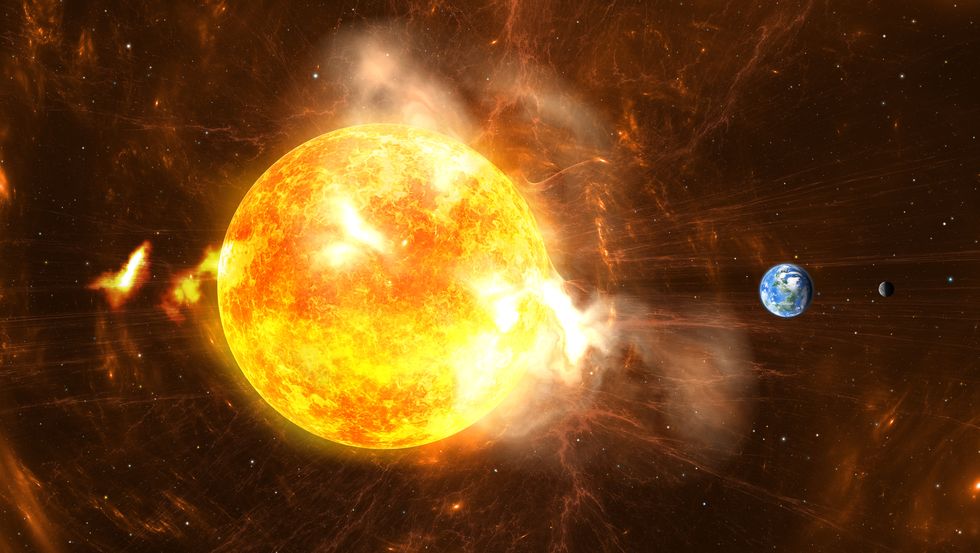
The first half of the article (Dutch) can be read for free, for the second part you need a subscription: https://www.quest.nl/natuur/sterrenkunde/a44034021/wat-is-een-geomagnetische-storm/
STCE on demand: Ionospheric SWIC Course
The STCE welcomed colleagues from the Geodetic Observatory Wettzell, which is part of the German Federal Agency for Cartography and Geodesy, for a dedicated Space Weather Introductory course.
At their request, we developed an entry-level course on space weather, ionospheric weather and its impacts. We welcomed new speakers and added a working meeting at the end of the course to foster new collaborations.
Our newest creation was seen as a success and so we decided that a course which focusses on impacts on ionospheric wave propagation will become part of our regular SWIC portfolio.
A first edition with open registrations will be held in December: check it out on https://events.spacepole.be/event/173/
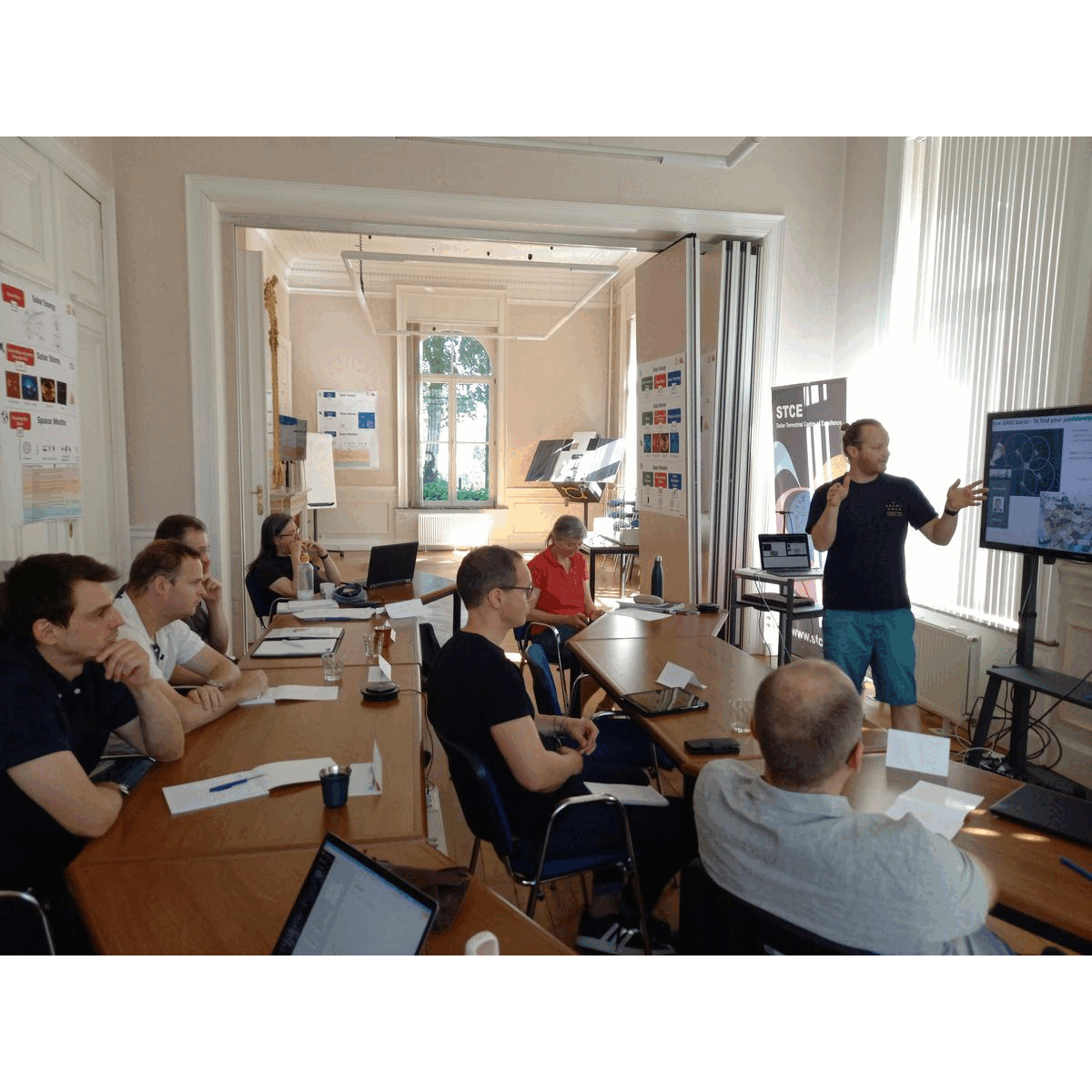
Job Opportunity in Bavaria
Permanent position as Development engineer in the field of Galileo monitoring
The Federal Agency for Cartography and Geodesy is offering a permanent position for a talented Development Engineer (m/f/d) to strengthen its team at the Geodetic Observatory Wettzell in Bad K�tzting in the field of Galileo monitoring.
You will work in a high-tech field and use the technical possibilities of radio telescopes, satellite receiving systems and other extensive sensor technology for your work. Development and operation go hand in hand.
You can find further information (in German) at https://www.bkg.bund.de/SharedDocs/Stellenangebote/BKG/DE/230622-G5_112023-EG14.html.
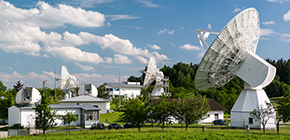
Open Doors at the Humain Radioastronomy Station
Get ready to explore the mysteries of the universe at the Humain Radioastronomy Station!
As part of the European Heritage Days 2023, the station is opening its doors to the public, a very rare occasion. Discover the operational instruments, learn about solar physics, astronomy, shooting stars, and very low frequency whistlers through interactive exhibitions and practical demonstrations.
Immerse yourself in the stunning views of the surrounding fields and marvel at the iconic legacy radio-astronomical instrument.
Don't miss this unique opportunity to visit this site which is normally not accessible to the public.
Block September 9 and 10 in you agenda!
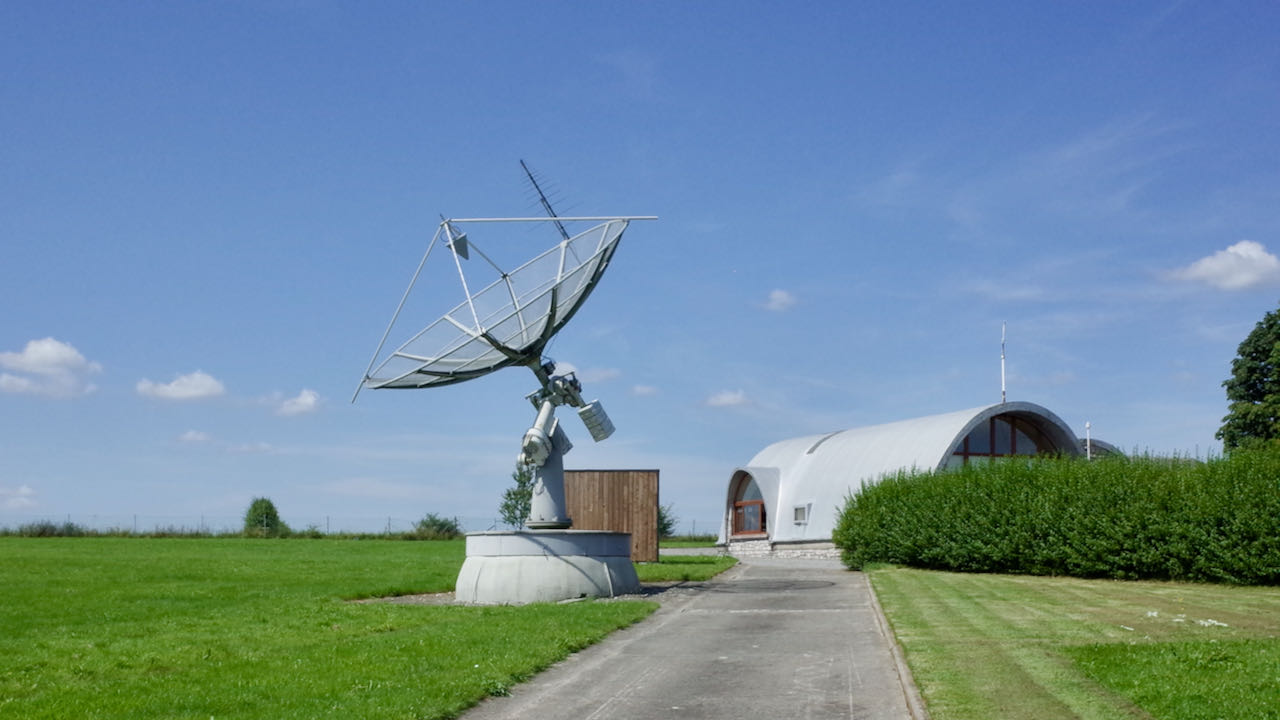
Review of Space Weather
Solar Active Regions (ARs) and flares
Solar flaring activity was at low levels for most of the past week with the exception of 7 June and 9 June. A total of 40 C-class flares and 2 M-class flares were reported.
NOAA Active Region (AR) 3327 (magnetic configuration Beta-Gamma-Delta) produced an M4.7 flare, peaking at 11:46 UTC on June 07, while NOAA AR 3331 (magnetic configuration Beta) produced an M2.5 flare, peaking at 17:11 UTC on June 09. These regions were the sources of the majority of the flaring activity over the past week, together with NOAA AR 3323 (magnetic configuration Beta-Gamma).
Coronal mass ejections
Multiple filament and prominence eruptions were observed throughout the week, most of which did not result in an Earth-directed coronal mass ejection (CME).
A filament eruption occurred in the southwestern quadrant of the Sun from around 08:30 UTC on June 4th. The associated coronal mass ejection (CME) was observed in SoHO/LASCO C2 coronagraph data from 10:36 UTC on June 4th. The CME was directed to the south-west and the bulk of the CME was not expected to be Earth directed. However, a glancing blow of the shock was predicted to impact Earth in the late evening of June 07 or in the first half of June 08. Indeed, a shock was observed in the solar wind on June 07 at 22:10 UTC, that might be associated to the CME.
Another CME was observed in SOHO/LASCO-C2 at around 17:24 UTC on June 09, likely related to the M2.5 flare from NOAA AR 3331. The CME is directed to the south-east and the bulk of the CME is not expected to be Earth directed. However, a glancing blow of the shock may impact Earth in the late evening of June 13 or in the first half of June 14.
Coronal Holes
Two positive polarity coronal holes, one in the northern hemisphere (N30) and one the southern hemisphere (S40) were visible in the week. The first one has crossed the central meridian on June 08 and the second one on June 10.
Proton flux levels
The greater than 10 MeV proton flux was at the background levels over the past week.
Electron fluxes at GEO
The greater than 2 MeV electron flux remained below the 1000 pfu threshold.
The 24h electron fluence was at nominal levels for the week.
Solar wind
The solar wind parameters (ACE and DSCOVR) were slightly elevated at the start of the week. By June 06, the solar wind parameters had returned to a near slow solar wind regime. However, at 22:23 UTC on June 07, a small shock-like structure was observed in the solar wind. This may be related to the CME from June 04.
From June 11 onwards, a high-speed stream from a positive polarity coronal hole began to influence the Earth. The solar wind velocity followed an increasing trend, rising from 310 km/s to 450 km/s.
Geomagnetism
The geomagnetic conditions were at quiet to unsettled levels (NOAA KP 1-3 and K-Bel1-3) over the week, with an isolated active period from 18:00 UTC until 21:00 UTC on June 04.
International Sunspot Number by SILSO
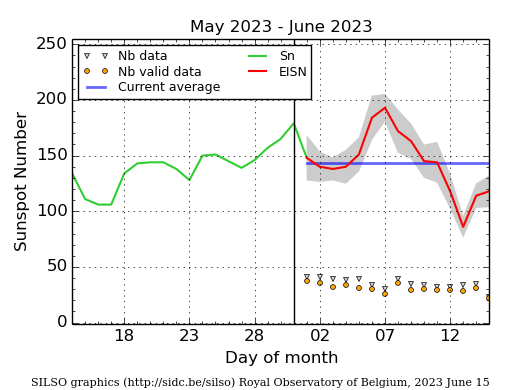
The daily Estimated International Sunspot Number (EISN, red curve with shaded error) derived by a simplified method from real-time data from the worldwide SILSO network. It extends the official Sunspot Number from the full processing of the preceding month (green line), a few days more than one solar rotation. The horizontal blue line shows the current monthly average. The yellow dots give the number of stations that provided valid data. Valid data are used to calculate the EISN. The triangle gives the number of stations providing data. When a triangle and a yellow dot coincide, it means that all the data is used to calculate the EISN of that day.
Noticeable Solar Events
| DAY | BEGIN | MAX | END | LOC | XRAY | OP | 10CM | TYPE | Cat | NOAA |
| 07 | 1118 | 1146 | 1159 | M4.7 | 100 | II/1 | 3327 | |||
| 09 | 1648 | 1711 | 1725 | M2.5 | II/1I/1 | 25 | 3331 |
| LOC: approximate heliographic location | TYPE: radio burst type |
| XRAY: X-ray flare class | Cat: Catania sunspot group number |
| OP: optical flare class | NOAA: NOAA active region number |
| 10CM: peak 10 cm radio flux |
PROBA2 Observations
Solar Activity
Solar flare activity fluctuated from low to moderate during the week.
In order to view the activity of this week in more detail, we suggest to go to the following website from which all the daily (normal and difference) movies can be accessed: https://proba2.oma.be/ssa
This page also lists the recorded flaring events.
A weekly overview movie (SWAP week 689) can be found here: https://proba2.sidc.be/swap/data/mpg/movies/weekly_movies/weekly_movie_2023_06_05.mp4.
Details about some of this week's events can be found further below.
If any of the linked movies are unavailable they can be found in the P2SC movie repository here:
https://proba2.oma.be/swap/data/mpg/movies/.
Wednesday June 07
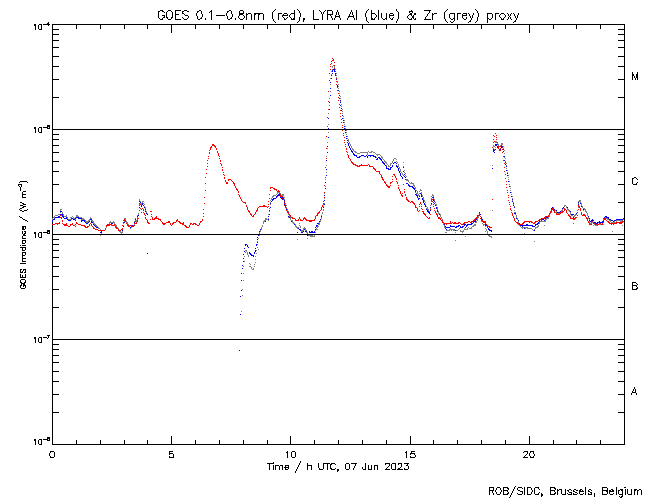
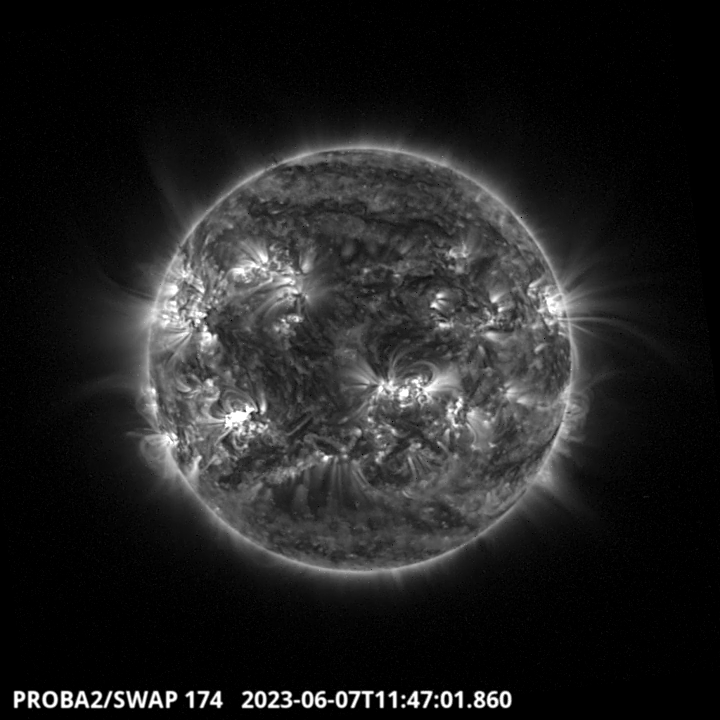
The largest flare of the week, an M4.7, was observed by LYRA (top panel) and SWAP (bottom panel). The flare occurred on 2023-Jun-07 (peak at 11:46 UT) in the south-western hemisphere, and it was associated with NOAA AR3327.
Find a SWAP movie of the event here: https://proba2.sidc.be/swap/movies/20230607_swap_movie.mp4.
Geomagnetic Observations in Belgium
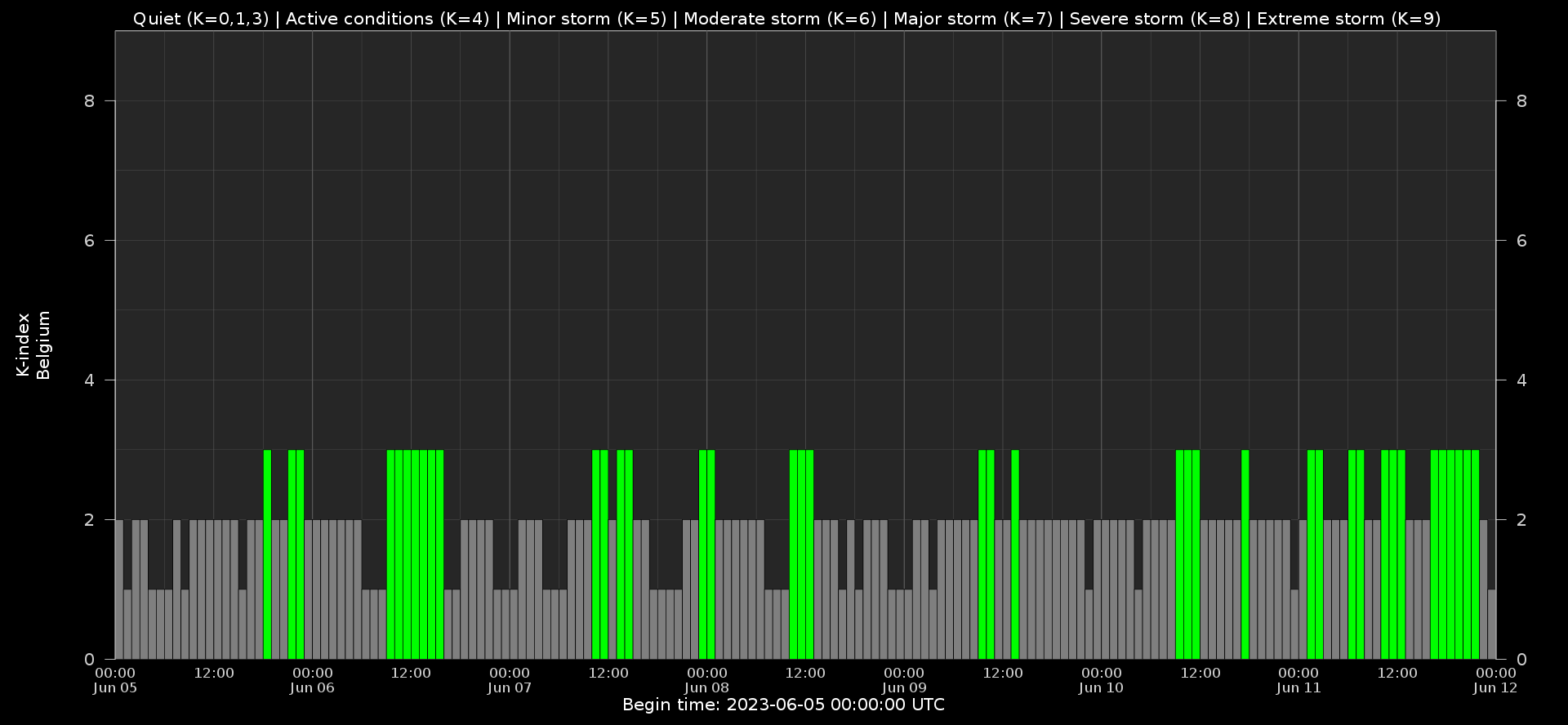
Local K-type magnetic activity index for Belgium based on data from Dourbes (DOU) and Manhay (MAB). Comparing the data from both measurement stations allows to reliably remove outliers from the magnetic data. At the same time the operational service availability is improved: whenever data from one observatory is not available, the single-station index obtained from the other can be used as a fallback system.
Both the two-station index and the single station indices are available here: http://ionosphere.meteo.be/geomagnetism/K_BEL/
Review of Ionospheric Activity

The figure shows the time evolution of the Vertical Total Electron Content (VTEC) (in red) during the last week at three locations:
a) in the northern part of Europe(N 61deg E 5deg)
b) above Brussels(N 50.5deg, E 4.5 deg)
c) in the southern part of Europe(N 36 deg, E 5deg)
This figure also shows (in grey) the normal ionospheric behaviour expected based on the median VTEC from the 15 previous days.
The VTEC is expressed in TECu (with TECu=10^16 electrons per square meter) and is directly related to the signal propagation delay due to the ionosphere (in figure: delay on GPS L1 frequency).
The Sun's radiation ionizes the Earth's upper atmosphere, the ionosphere, located from about 60km to 1000km above the Earth's surface.The ionization process in the ionosphere produces ions and free electrons. These electrons perturb the propagation of the GNSS (Global Navigation Satellite System) signals by inducing a so-called ionospheric delay.
See http://stce.be/newsletter/GNSS_final.pdf for some more explanations ; for detailed information, see http://gnss.be/ionosphere_tutorial.php
The SIDC Space Weather Briefing
The Space Weather Briefing presented by the forecaster on duty from June 5 to 11.
It reflects in images and graphs what is written in the Space Weather Activity report: https://www.stce.be/briefings/20230612_SWbriefing.pdf
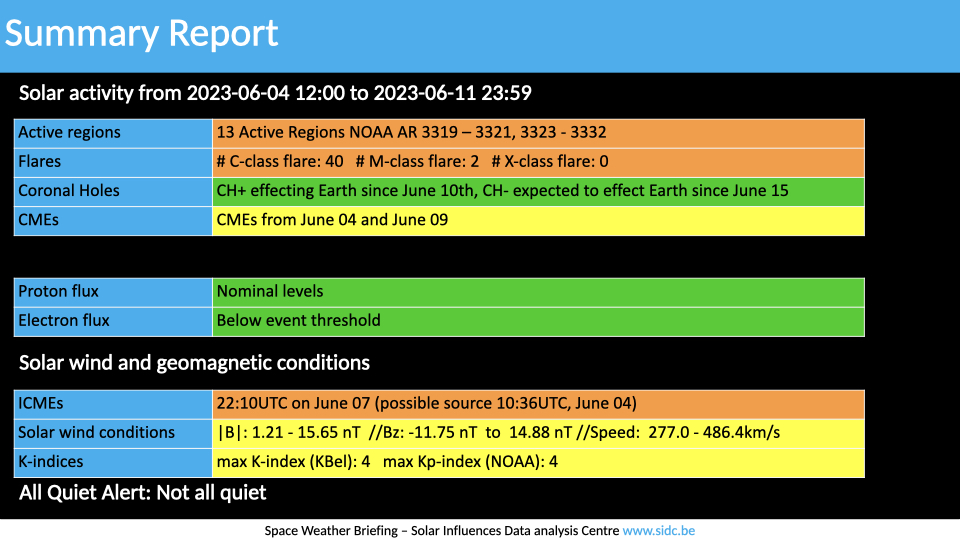
If you need to access the movies, contact us: stce_coordination at stce.be
Upcoming activities
Check out our activity calendar: activities and encounters with the Sun-Space-Earth system and Space Weather as the main theme. We provide occasions to get submerged in our world through educational, informative and instructive activities.
If you want your event in our calendar, contact us: stce_coordination at stce.be
* June 23. BIRA-IASB seminar: Building a science support service dedicated towards validation and monitoring of CO2M and extendable to other satellite missions, Nicolet rooms, Brussels, Belgium
* June 29, STCE annual meeting, Brussels, Belgium
* June 30, Public presentation: Een nog beter begrip van de Zon dankzij de satelliet Solar Orbiter, MIRA, Grimbergen, Belgium
* Aug 21, Lecture: The Sun, VVS Summerschool, Leuven, Belgium
* Sep 18-20, STCE Space Weather Introductory Course, Brussels, Belgium - Registrations are open
* Sep X, post-Space Weather Introductory Course, by JMG, date and place TBD - registration is included in the Sep SWIC
* Nov 18-19, e-SWAN Space Weather School: data, models and services, by the STCE, Toulouse, France
* Sept 9-10, Open Doors at the Humain Radioastronomy Station, Humain, Belgium
* Dec 4-6, STCE course: Space Weather impacts on ionospheric wave propagation - focus on GNSS and HF, Brussels, Belgium - Registrations are open
* Jan 22-24, 2024, STCE Space Weather Introductory Course, Brussels, Belgium - Registrations are open
* Jan 25, 2024, post-Space Weather Introductory Course, by JMG and MeteoWing, place TBD - registration is included in the Jan SWIC
Check: https://www.stce.be/calendar
